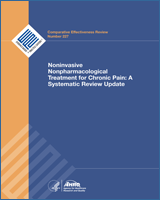From: Methods

NCBI Bookshelf. A service of the National Library of Medicine, National Institutes of Health.
| PICOTS | Inclusion | Exclusion |
|---|---|---|
Population All KQs | General Inclusion Criteria
| General Exclusion Criteria
|
Population | KQ1: Low back pain
| KQ1: Low back pain
|
Population | KQ2: Neck pain
| KQ2: Neck pain
|
Population | KQ3: Osteoarthritis
| KQ3: Osteoarthritis
|
Population | KQ4: Fibromyalgia
| KQ4: Fibromyalgia
|
Population | KQ5: Headache
| KQ5: Headache
|
| Interventions | All KQs:
| All KQs:
|
| Comparators | All KQs, subquestion a
| All KQs:
|
| Outcomes | All KQs: Primary efficacy outcomes; we will focus on outcomes from validated measures for Harms and Adverse effectsSecondary outcomes
| All KQs:
|
| Timing | Duration of followup: short term (1 to <6 months), intermediate term (≥6 to <12 months) and long term (≥12 months); focus on longer term (>12 month) effects. Trials lasting ≥6 months that include a supervised intervention followed by continued home treatment as part of the intervention will be included even though the only followup occurs directly after the intervention. |
|
| Studies | Randomized controlled trials or high quality systematic reviews of randomized controlled trials published in English; cross-over trials with random assignment of initial treatment will be considered. | All KQs:
|
| Settings | Any nonhospital setting or in self-directed care |
|
CBD = cannabidiol; FDA = Food and Drug Administration; KQ = Key Question; MAOI = monoamine oxidase inhibitor; NSAID = nonsteroidal anti-inflammatory drug; PICOTS = populations, interventions, comparators, outcomes, timing, settings, study designs; SNRI = serotonin and norepinephrine reuptake inhibitor; SSRI = selective serotonin reuptake inhibitor; TCA = tricyclic antidepressant; THC = tetrahydrocannabinol.
Multidisciplinary rehabilitation (MDR) (also known as interdisciplinary rehabilitation), is defined as a coordinated program with biopsychosocial treatment components (e.g., exercise therapy and cognitive-behavioral therapy) provided by professionals from at least two different specialties. Functional restoration training is included as part of MDR.
Different forms of exercise will not be compared to each other. Exercise will be compared with nonexercise interventions for low back pain, neck pain, fibromyalgia and osteoarthritis
Different forms of biofeedback will not be compared to each other. Biofeedback will be compared with the noninvasive interventions for chronic headache
The magnitude of effects for pain and function will be classified using the same system as in the AHRQ-funded noninvasive treatment for low back pain review recognizing that small effects using this system may not meet standard thresholds for clinically meaningful effects. A small effect was defined for pain as a mean between-group difference following treatment of 5 to 10 points on a 0- to 100-point visual analog scale (VAS), 0.5 to 1.0 points on a 0- to 10-point numeric rating scale, or equivalent; for function as a mean difference of 5- to 10-point difference on the 0- to 100-point Oswestry Disability Index (ODI) or 1 to 2 points on the 0- to 24-point Roland-Morris Disability Questionnaire (RDQ), or equivalent; and for any outcome as a standardized mean difference (SMD) of 0.2 to 0.5. A moderate effect was defined for pain as a mean difference of 10 to 20 points on a 0- to 100-point VAS, for function as a mean difference of 10 to 20 points on the ODI or 2 to 5 points on the RDQ, and for any outcome as an SMD of 0.5 to 0.8. Large/substantial effects were defined as greater than moderate. We will apply similar methodology to outcomes measures for the other condition. The clinical relevance of effects classified as small might vary for individual patients depending on preferences, baseline symptom severity, harms, cost, and other factors
From: Methods

NCBI Bookshelf. A service of the National Library of Medicine, National Institutes of Health.